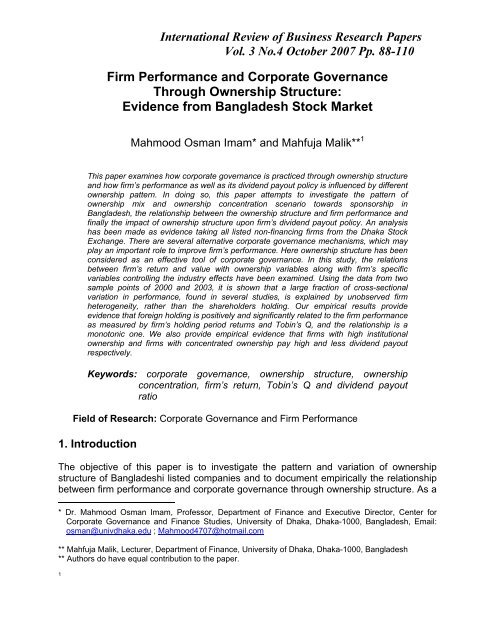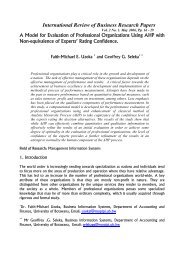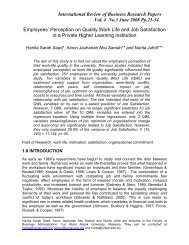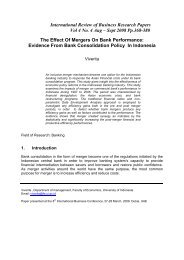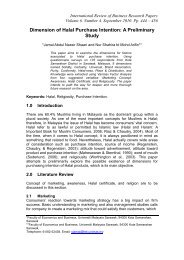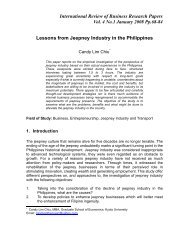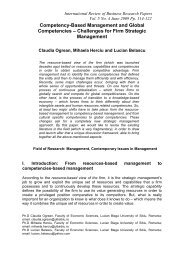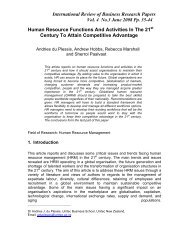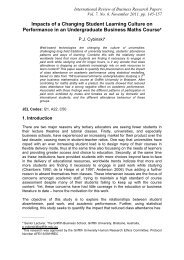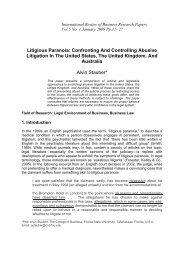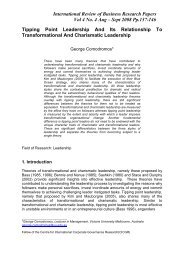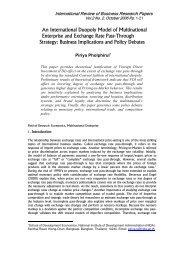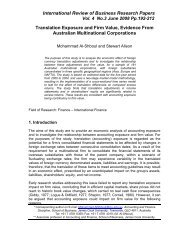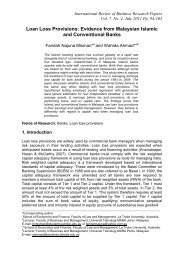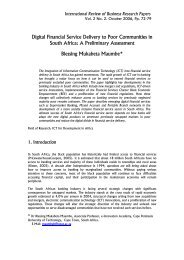Firm Performance and Corporate Governance Through Ownership ...
Firm Performance and Corporate Governance Through Ownership ...
Firm Performance and Corporate Governance Through Ownership ...
Create successful ePaper yourself
Turn your PDF publications into a flip-book with our unique Google optimized e-Paper software.
International Review of Business Research Papers<br />
Vol. 3 No.4 October 2007 Pp. 88-110<br />
<strong>Firm</strong> <strong>Performance</strong> <strong>and</strong> <strong>Corporate</strong> <strong>Governance</strong><br />
<strong>Through</strong> <strong>Ownership</strong> Structure:<br />
Evidence from Bangladesh Stock Market<br />
Mahmood Osman Imam* <strong>and</strong> Mahfuja Malik** 1<br />
This paper examines how corporate governance is practiced through ownership structure<br />
<strong>and</strong> how firm’s performance as well as its dividend payout policy is influenced by different<br />
ownership pattern. In doing so, this paper attempts to investigate the pattern of<br />
ownership mix <strong>and</strong> ownership concentration scenario towards sponsorship in<br />
Bangladesh, the relationship between the ownership structure <strong>and</strong> firm performance <strong>and</strong><br />
finally the impact of ownership structure upon firm’s dividend payout policy. An analysis<br />
has been made as evidence taking all listed non-financing firms from the Dhaka Stock<br />
Exchange. There are several alternative corporate governance mechanisms, which may<br />
play an important role to improve firm’s performance. Here ownership structure has been<br />
considered as an effective tool of corporate governance. In this study, the relations<br />
between firm’s return <strong>and</strong> value with ownership variables along with firm’s specific<br />
variables controlling the industry effects have been examined. Using the data from two<br />
sample points of 2000 <strong>and</strong> 2003, it is shown that a large fraction of cross-sectional<br />
variation in performance, found in several studies, is explained by unobserved firm<br />
heterogeneity, rather than the shareholders holding. Our empirical results provide<br />
evidence that foreign holding is positively <strong>and</strong> significantly related to the firm performance<br />
as measured by firm’s holding period returns <strong>and</strong> Tobin’s Q, <strong>and</strong> the relationship is a<br />
monotonic one. We also provide empirical evidence that firms with high institutional<br />
ownership <strong>and</strong> firms with concentrated ownership pay high <strong>and</strong> less dividend payout<br />
respectively.<br />
Keywords: corporate governance, ownership structure, ownership<br />
concentration, firm’s return, Tobin’s Q <strong>and</strong> dividend payout<br />
ratio<br />
Field of Research: <strong>Corporate</strong> <strong>Governance</strong> <strong>and</strong> <strong>Firm</strong> <strong>Performance</strong><br />
1. Introduction<br />
The objective of this paper is to investigate the pattern <strong>and</strong> variation of ownership<br />
structure of Bangladeshi listed companies <strong>and</strong> to document empirically the relationship<br />
between firm performance <strong>and</strong> corporate governance through ownership structure. As a<br />
* Dr. Mahmood Osman Imam, Professor, Department of Finance <strong>and</strong> Executive Director, Center for<br />
<strong>Corporate</strong> <strong>Governance</strong> <strong>and</strong> Finance Studies, University of Dhaka, Dhaka-1000, Bangladesh, Email:<br />
osman@univdhaka.edu ; Mahmood4707@hotmail.com<br />
** Mahfuja Malik, Lecturer, Department of Finance, University of Dhaka, Dhaka-1000, Bangladesh<br />
** Authors do have equal contribution to the paper.<br />
1
Imam & Malik 89<br />
consequence, this paper deals with what impact does ownership structure has on firm<br />
performance <strong>and</strong> dividend payout policy.<br />
The need for corporate governance arises from the potential conflicts of interest among<br />
participants (stakeholders) in the corporate structure. These conflicts of interest often<br />
arise from two main reasons. First, different participants have different goals <strong>and</strong><br />
preferences. Second, the participants have imperfect information as to each other’s<br />
actions, knowledge, <strong>and</strong> preferences. Jensen <strong>and</strong> Meckling (1976) addressed these<br />
conflicts by examining the separation of corporate ownership from corporate<br />
management. They noted that this separation, with the absence of other corporate<br />
governance mechanisms, provides executives with the ability to act in their own selfinterest<br />
rather than in the interests of shareholders. Of the all corporate governance<br />
mechanism that have been studied in US <strong>and</strong> UK, ownership structure is the one that<br />
has probably been studied extensively in the rest of the world. This is probably because<br />
in countries other than UK <strong>and</strong> US, corporate governance mechanisms like an active<br />
market for corporate control, managerial labor market, stock-based managerial<br />
compensation scheme, independent directors in the board, provision of executive<br />
committee <strong>and</strong> audit committee chaired by independent director etc. are not very<br />
effective in the setting of weak regulatory <strong>and</strong> legal framework, <strong>and</strong> in the absence of<br />
full functioning of capital market. In this setting, governance through ownership structure<br />
becomes the most important element of corporate governance. Bangladesh fits neatly<br />
into this situation. Hence, this study investigates whether ownership structure has any<br />
significant effects on the performance of the listed companies in Dhaka Stock Exchange<br />
<strong>and</strong> firm payout policy. The listed companies allow us to quantify the ownership mix <strong>and</strong><br />
concentration <strong>and</strong> thus provide a unique opportunity for studying the above issue.<br />
This paper attempts to identify the different dimensions that could predict the<br />
relationship between firm’s performance <strong>and</strong> ownership structure after controlling for<br />
firm’s specific variables <strong>and</strong> industry effects. Using the data from two sample points of<br />
2000 <strong>and</strong> 2003, it is shown that a large fraction of cross-sectional variation in<br />
performance, found in several studies, is explained by unobserved firm heterogeneity,<br />
rather than the shareholders holding. Our empirical results provide evidence that foreign<br />
holding is positively <strong>and</strong> significantly related to the firm performance as measured by<br />
firm’s holding period returns <strong>and</strong> Tobin’s Q, <strong>and</strong> the relationship is a non-monotonic<br />
one. We also observed the findings that firms with high institutional ownership <strong>and</strong> firms<br />
with concentrated ownership pay high <strong>and</strong> less dividend payout respectively.<br />
The paper is organized as follows: Section 2 provides underpinnings of the concept of<br />
corporate governance followed by the literature review on ownership structure <strong>and</strong> firm<br />
performance. In section 3 the hypotheses being developed focus the nature of<br />
corporate governance through ownership structure along with firm’s specific<br />
performance measured variables. In section 4 empirical models to test these<br />
hypotheses are given. Next, in sections 5, 6 <strong>and</strong> 7, the data sources <strong>and</strong> sample<br />
description, overview of ownership structure <strong>and</strong> concentration, <strong>and</strong> definitions of<br />
variables are shown respectively. Section 8 elaborately explains the empirical results of<br />
our main study. Lastly, all the findings about this study would help us to draw the<br />
89
Imam & Malik 90<br />
ultimate conclusion about the impact of corporate governance practice through<br />
ownership structure upon firm’s performance.<br />
2. <strong>Corporate</strong> <strong>Governance</strong> <strong>and</strong> Overview of <strong>Ownership</strong> Structure<br />
<strong>Corporate</strong> governance is an important effort to ensure accountability <strong>and</strong> responsibility<br />
<strong>and</strong> a set of principles, which should be incorporated into every part of the organization.<br />
Though it is viewed as a recent issue, there is, in fact, nothing new about the concept.<br />
Because it has been in existence as long as the corporation itself – as long as there has<br />
been large–scale trade, reflecting the need for responsibility in the h<strong>and</strong>ling of money<br />
<strong>and</strong> the conduct of commercial activities. <strong>Corporate</strong> governance has succeeded to<br />
attract a great deal of interest as it focuses not only the long-term relationship, which<br />
has to deal with checks <strong>and</strong> balances, incentives for managers <strong>and</strong> communications<br />
between management <strong>and</strong> investors but also the transactional relationship, which<br />
involves dealing with disclosure <strong>and</strong> authority.<br />
The corporate governance framework is the widest control mechanism, both internal<br />
<strong>and</strong> external, to encourage the efficient use of corporate resources <strong>and</strong> equally to<br />
require accountability for the stewardship of those resources. The challenge of<br />
corporate governance could help to align the interests of individuals, corporations <strong>and</strong><br />
society through a fundamental ethical basis <strong>and</strong> it will fulfill the long-tem strategic goal<br />
of the owners, which, after survival may consist of building shareholder value,<br />
establishing a dominant market share or maintaining a technical lead in a chosen<br />
sphere. It will certainly not be the same for all organizations, but will take into account<br />
the expectations of all the key stakeholders, in particular: considering <strong>and</strong> caring for the<br />
interests of employees, customers <strong>and</strong> suppliers, stockholders <strong>and</strong> debt holders, state<br />
<strong>and</strong> local community, both in terms of the physical effects of the company’s operations<br />
<strong>and</strong> the economic <strong>and</strong> cultural interaction with the population. So maintaining proper<br />
compliance with all the applicable legal <strong>and</strong> regulatory requirements under which the<br />
company is carrying out its activities is also achieved by sound practice of corporate<br />
governance.<br />
Theoretical position of corporate governance states that firm’s control by shareholders<br />
should be raised as much as possible. Specifically, the essence of this position is to<br />
straighten the surveillance of the stock market through such means as stockownership,<br />
institutionalized monitoring by shareholders at general shareholder meeting <strong>and</strong><br />
corporate take over. In practical position, two distinct forms of governance system<br />
separately developed for large corporations in economic <strong>and</strong> financial literature were<br />
named as the Anglo-American type (outsider system) & the Japanese-German type<br />
(insider system). There are a number of striking differences in concentration <strong>and</strong> nature<br />
of ownership between both systems. For example, in a typical Continental European<br />
country under Japan German system (majority) control is held by one shareholder or a<br />
small group of interlocked (corporate) shareholders, whereas Anglo-American<br />
companies are predominantly widely held. So the Anglo-American type is dominated by<br />
shareholders interest through the market corporate control. On the contrary in the<br />
Japanese-German type the large block of stable shareholding by financial institutions<br />
90
Imam & Malik 91<br />
<strong>and</strong> the prevalence of interlocking shareholding effectively prevent hostile takeovers<br />
<strong>and</strong>, hence, the average shareholder would seem to have very little influence. However,<br />
these two systems work to the extent depending on financial structure of the country.<br />
<strong>Corporate</strong> governance has received new urgency because of global financial crisis <strong>and</strong><br />
major corporate failures that shock major financial centers of the world. Research on<br />
corporate governance across the countries has focused on diverse elements <strong>and</strong><br />
dimensions as the breadth <strong>and</strong> depth of it. In practice, corporate governance <strong>and</strong><br />
monitoring mechanisms recently focused on matters like the composition of the Board<br />
of Directors, the duties <strong>and</strong> responsibilities of the executive directors, regular monitoring<br />
by shareholders, anti takeover devices, voting rights of shareholders <strong>and</strong> detailed<br />
disclosure of company information that are material for decision making by interested<br />
parties. The corporate governance framework should protect <strong>and</strong> facilitate the exercise<br />
of shareholders’ rights. Shareholders should have the right to participate in, <strong>and</strong> to be<br />
sufficiently informed on, decisions concerning fundamental corporate changes.<br />
Shareholders, including institutional shareholders, should be allowed to consult with<br />
each other on issues concerning their basic shareholder rights as defined in the<br />
Principles, subject to exceptions to prevent abuse. The equitable treatment of all<br />
shareholders, including minority <strong>and</strong> foreign shareholders should be ensured by<br />
corporate governance also. Minority shareholders should be protected from abusive<br />
actions by, or in the interest of, controlling shareholders acting either directly or<br />
indirectly. Stakeholders, including individual employees <strong>and</strong> their representative bodies,<br />
should be able to freely communicate their concerns about illegal or unethical practices<br />
to the board <strong>and</strong> their rights should not be compromised for doing this. Another<br />
important responsibility of corporate governance is the timely <strong>and</strong> accurate disclosure of<br />
all material matters regarding the corporation. Information should be prepared <strong>and</strong><br />
disclosed in accordance with high quality st<strong>and</strong>ards of accounting <strong>and</strong> financial <strong>and</strong><br />
non-financial disclosure. Board members should act on a fully informed basis, in good<br />
faith, with due diligence <strong>and</strong> care, <strong>and</strong> in the best interest of the company <strong>and</strong> the<br />
shareholders. The board should apply high ethical st<strong>and</strong>ards. Board members should<br />
be able to commit themselves effectively to their responsibilities.<br />
The public image of a corporation will quite accurately reflect the culture of that body. If<br />
follows, then, that good corporate governance has to be in the bones <strong>and</strong> bloodstream<br />
of the organization since this in turn will be reflected in the culture. Adherence to the<br />
principle of good corporate governance serves to foster investor confidence <strong>and</strong> attract<br />
domestic as well as foreign investors. But Bangladesh is sadly lagging behind in this<br />
respect. Recently as a regulatory body, Securities <strong>and</strong> Exchange Commission,<br />
Bangladesh strives to stimulate the listed companies comply the corporate governance<br />
guidelines issued by them so that the suppliers of funds assure themselves of getting a<br />
return on their investment. In case of any infringement of this effort, listed companies<br />
have to show grounds with proper explanations in deed.<br />
It is seen from the table of ownership holding by top five shareholders classified by<br />
industry that ownership in Bangladesh is largely concentrated in a few h<strong>and</strong>s especially<br />
91
Imam & Malik 92<br />
in non-financial publicly listed firms. It is observed that these top shareholders belong<br />
mostly to controlling family.<br />
Table-0<br />
<strong>Ownership</strong> Concentration by Top Shareholders <strong>and</strong> Industry<br />
Top 3<br />
Shareholders<br />
Top 5<br />
Shareholders<br />
Top 10<br />
Shareholders<br />
Industry (No.) mean median mean median mean median<br />
Banks (23) 17.89% 11.43% 23.88% 16.22% 30.67% 26.50%<br />
Engineering (19) 38.29% 37.37% 41.11% 38.19% 42.84% 40.87%<br />
Food (32) 34.15% 31.33% 38.77% 36.61% 41.32% 38.76%<br />
Fuel & Power (4) 37.72% 42.44% 41.06% 49.11% 43.52% 54.04<br />
Jute (4) 38.82% 35.91% 40.31% 37.71% 41.83% 40.74%<br />
Textile (39) 37.52% 35.47% 42.52% 43.99% 45.32% 47.77%<br />
Pharmacutical (26) 38.94% 36.63% 41.78% 42.39% 43.86% 45.64%<br />
Paper (7) 35.84% 36.58% 40.67% 45.49% 44.92% 50.00%<br />
Service & Real<br />
Estate(5) 50.65% 39.62% 54.34% 47.79% 56.56% 48.12%<br />
Cement (8) 38.03% 37.12% 40.76% 42.82% 42.62% 50.22%<br />
IT (6) 27.34% 28.50% 34.48% 32.44% 37.03% 38.89%<br />
Tannery (8) 32.89% 31.12% 36.11% 33.10% 38.43% 38.42%<br />
Ceramic (4) 36.11% 33.75% 40.30% 35.40% 40.30% 39.09%<br />
Insurance (23) 13.70% 12.33% 19.96% 18.67% 31.94% 31.20%<br />
Miscellaneous (10) 31.25% 36.20% 36.69% 39,73% 40.80% 40.76%<br />
All (218) 32.33% 30.24% 36.96% 36.50% 41.06% 41.28%<br />
2.1 Literature review on ownership structure <strong>and</strong> firm performance<br />
Using 361 German corporations over the time period 1991 to 1996 Erik Lehmann <strong>and</strong><br />
Jürgen Weig<strong>and</strong> (February 2000) documented that (1) the presence of large<br />
shareholders does not necessarily enhance profitability, <strong>and</strong> (2) the high degree of<br />
ownership concentration seems to be a sub-optimal choice for many of the tightly held<br />
German corporations. Their results also imply ownership concentration to affect<br />
profitability significantly negatively. Their empirical evidence suggests that<br />
representation of owners on the board of executive directors does not make a<br />
difference. The negative effect of ownership concentration can be traced back to familyor<br />
foreign-owned non-quoted firms as well as quoted firms with different large<br />
shareholders. A positive impact of ownership concentration on profitability, supportive of<br />
managerial discretion <strong>and</strong> agency theories, shows up for quoted firms, which have<br />
financial institutions as large shareholders.<br />
92
Imam & Malik 93<br />
Karl V. Lins (2002) investigates whether management ownership structures <strong>and</strong> large<br />
non-management blockholders are related to firm value across a sample of 1433 firms<br />
from 18 emerging markets. He finds that large non-management control rights<br />
blockholdings (having more control rights) are positively related to firm value measured<br />
by Tobin’s Q. He also provides evidence that large non management blockholders can<br />
mitigate the valuation discounts associated with the expected agency problem.<br />
In 1985, Demstez <strong>and</strong> Lehn argued both that the optimal corporate ownership structure<br />
was firm specific, <strong>and</strong> that market competition would derive firms toward that optimum.<br />
Because ownership was endogenous to expected performance, they cautioned, any<br />
regression of profitability on ownership patterns should yield insignificant results.<br />
Yoshiro Miwa <strong>and</strong> Mark Ramseyer (February 2001) stated with a sample of 637<br />
Japanese firms <strong>and</strong> confirmed the equilibrium mechanism behind Demstez-Lehn.<br />
Using a sample of 144 Israeli firms, Beni Lauterbach1 <strong>and</strong> Efrat Tolkowsky (June 2004)<br />
find that Tobin's Q is maximized when control group vote reaches 67%. This evidence is<br />
strong when ownership structure is treated as exogenous <strong>and</strong> weak when it is<br />
considered endogenous.<br />
Steen Thomsen <strong>and</strong> Torben Pedersen (1997) examine the impact of ownership<br />
structure on company economic performance in the largest companies from 12<br />
European nations. According to their findings the positive marginal effect of ownership<br />
ties to financial institutions is stronger in the market-based British system than in<br />
continental Europe.<br />
Christoph Kaserer <strong>and</strong> Benjamin Moldenhauer (September 2005) address the question<br />
whether there is any empirical relationship between corporate performance <strong>and</strong> insider<br />
ownership. Using a data set of 245 Germen firms for the year 2003 they find evidence<br />
for a positive <strong>and</strong> significant relationship between corporate performance, as measured<br />
by stock price performance as well as by Tobin’s Q, <strong>and</strong> insider ownership.<br />
Michael L Lemmon <strong>and</strong> Karl V Lins ( August 2003) use a sample of 800 firms in eight<br />
East Asian countries to study the effect of ownership structure on value during the<br />
region’s financial crisis. The crisis negatively impacted firm’s investment opportunities,<br />
raising the incentives of controlling shareholders to expropriate minority investors. The<br />
evidence is consistent with the view that ownership structure plays an important role in<br />
determining whether insiders expropriate minority shareholders.<br />
3. Hypothesis to be tested<br />
This section provides an overview of the hypotheses. Regarding the determinants of the<br />
firm’s performance the following arguments <strong>and</strong> hypothesis can be developed:<br />
As ownership pattern varies across the firms, monitoring, controlling as well as<br />
execution of disciplining decision also changes. Different firms have ownership pattern.<br />
Some firms have sponsors as the largest shareholders; some have institutional or<br />
93
Imam & Malik 94<br />
managerial ownership as major. Different shareholders influence firm’s decision making<br />
differently. What the institutional owner can do may not be possible for the diffuse<br />
general public holding. So ownership concentration <strong>and</strong> different ownership mix<br />
contribute differently to the firms’ performance. This may lead the following hypothesis<br />
Hypothesis 1: <strong>Ownership</strong> structure has an impact upon the firm performance<br />
If sponsor shareholders are the majority, then they could try their best for personal<br />
benefit. So this type of concentration creates agency problem between controlling<br />
owner <strong>and</strong> minority shareholder. Minority shareholders fear the risk that they could be<br />
expropriated of their rights through the collusion of manager <strong>and</strong> controlling blockholder.<br />
Here, we assume sponsor ownership as a proxy variable of managerial ownership.<br />
Shleifer <strong>and</strong> Vishny (1988) show in the context of managerial ownership that high<br />
managerial ownership may entrench managers, as they are increasingly less subject to<br />
governance by board of directors <strong>and</strong> to discipline by the market for corporate control.<br />
From this empirical argument another hypothesis is taken.<br />
Hypothesis 2: If the proportion of the sponsor ownership in firm’s capital<br />
structure is high, it may have that minority stockholders will be deprived.<br />
<strong>Firm</strong>’s size may be measured in terms of total asset, market capitalization or sales.<br />
Whatever be the variable, higher the size, greater will be the operating as well as<br />
financing efficiency of the firm, as the firm becomes quite mature through economies of<br />
scale, production efficiency as well as managerial skill. Another hypothesis is made<br />
here.<br />
Hypothesis 3: The greater the size of the firm, higher the firms performance<br />
If the foreign holding in ownership structure increases, firm performance is positively<br />
motivated <strong>and</strong> governed to be improved. Basically foreign holdings take place <strong>and</strong> are<br />
increasing in those firms that have good governance <strong>and</strong> through these good<br />
governance practice, firm will improve doing better for all of its stakeholders. Thus a<br />
significant <strong>and</strong> positive relationship exists between firm’s return <strong>and</strong> foreign investment<br />
in a non-financial firm. So it could be said that:<br />
Hypothesis 4: Foreign holding is positively related with firm value <strong>and</strong><br />
performance.<br />
Leverage promotes a firm to lower its cost of capital. So leverage is cost effective <strong>and</strong> in<br />
another sense, the bondholders as well as the creditors will monitor more the<br />
management for their own sake as they do have the fear of bankruptcy. So leverage<br />
can be a proxy of corporate governance as there is a chance for more monitoring,<br />
controlling <strong>and</strong> governing. This argument promotes the following hypothesis:<br />
94
Imam & Malik 95<br />
Hypothesis 5: If leverage of a firm increases, it would improve the firm<br />
performance.<br />
Higher the listings age of the firm greater the efficiency, as the firms become matured<br />
more to deal with capital market. <strong>Firm</strong>’s performance can also be influenced by firm’s<br />
category. Better the category, more the firm is concerned about the stakeholders <strong>and</strong><br />
higher the firm’s efforts to its profitability, value, return <strong>and</strong> other performance. A<br />
hypothesis is developed from it as follows:<br />
Hypothesis 6: <strong>Firm</strong> performance is positively related with firm’s category <strong>and</strong> list<br />
age.<br />
If the majority holders are the sponsors, they do try to govern themselves ignoring the<br />
sake of other stakeholders. So the majority holder will try to gain personal benefit<br />
protecting cash flow to be distributed as dividend to the other minority holders. It may<br />
reduce agency conflict between management <strong>and</strong> major shareholders as they hold the<br />
both place, but the other stakeholders <strong>and</strong> minority shareholders will be deprived<br />
because of their entrenchment effect. It leads the following hypothesis:<br />
Hypothesis 7: If sponsor ownership concentration is high, dividend payout will be<br />
low.<br />
4. Model Specification<br />
An empirical model is developed here to judge the relationship between firm’s<br />
performance <strong>and</strong> ownership structure. Here, firm’s holding period return <strong>and</strong> Tobin’s Q<br />
variables are used as the measurement of firm’s performance. The dividend payout<br />
policy is also examines in this context. One thing is to be noted here that the meaning of<br />
ownership structure is two-fold in this paper: ownership concentration <strong>and</strong> ownership<br />
mix. It will then be compared the performance of firms with different degree of<br />
ownership concentration as well as different types of shareholding pattern. For these<br />
purposes, as mentioned earlier three dimensions (return, value <strong>and</strong> dividend policy)<br />
have been used as dependent variables. The dependent (performance <strong>and</strong> payout)<br />
variables are then regressed on concentration value <strong>and</strong> other ownership fractions such<br />
as sponsorship, institutional holding <strong>and</strong> foreign govt. share.<br />
Himmelberg et. al (1999) have argued that regression of firm performance on ownership<br />
variables is potentially misspecified because of the presence of the firm heterogeneity.<br />
Specially, if some of the unobserved determinants of firm performance are also<br />
determinants of ownership, then ownership might spuriously appear to be a determinant<br />
of firm performance. However, to provide primary evidence on the impact of ownership<br />
structure on firm performance <strong>and</strong> dividend payout policy of listed non-financial firms in<br />
DSE, this paper uses multiple regression technique with <strong>and</strong> without endogeneity<br />
correction. Hence, combining the firm specific observable variables associated with<br />
95
Imam & Malik 96<br />
share-holding pattern yields the following reduced form expression for the firm<br />
performance:<br />
Y it = α + β (∆ ownership) i t + δ X i t + γ (Industry) i t + ε i t<br />
where, the dependent variable Y it measures firm’s performance, all Greek letters<br />
represent coefficients of independent variables <strong>and</strong> it will describe the responsiveness<br />
of dependent variable as a result of a change in that specific independent variable if the<br />
other independent variables remain constant. ∆ ownership represents the changes in<br />
ownership pattern of different types of share holding, X i t represents firm- specific<br />
effect, Industry i is dummy variable to control industry variations <strong>and</strong> ε i t represents<br />
the error term. This is the basic generic equation on which the relationship between<br />
ownership structure <strong>and</strong> firm performance is examined using our selected observations.<br />
5. Data Sources <strong>and</strong> Sample Description<br />
5.1 Sources of data<br />
Data on required variables have been collected over the period from the documentation<br />
of Dhaka Stock Exchange. Most of the information is collected from monthly review<br />
published by DSE. Information about the selected firms is also gathered from the<br />
publications “Balance Sheet Analysis of Joint Stock Companies listed on the Dhaka<br />
Stock Exchange,” published by Statistical Department of Bangladesh Bank (2001-2002<br />
issue). Those, which are not found in these sources, are collected directly from the<br />
companies’ Annual Report documented in DSE <strong>and</strong> SEC.<br />
5.2 Sample description<br />
For the main analysis, non-financial firms from DSE are selected with the required data.<br />
As the target is to find out the relationship between ownership pattern <strong>and</strong> non-financial<br />
firm performance, banks, mutual funds <strong>and</strong> insurance companies are excluded. Here it<br />
is considered 2000 - 2003 as observation period. In 2003 total numbers of firms<br />
included in DSE are 259 but excluding the financial firms we do have 201 firms in<br />
observation. Basically cross sectional analysis is done here. Panel data is not used<br />
here; but to find out the effect of changes in ownership pattern upon firm performance<br />
two time points, 2000 <strong>and</strong> 2003, are selected. That is changes in performance are<br />
shown from 2000 to 2003 in contrast with the changes in ownership pattern for the<br />
same time. But some firms had not been listed in 2000 <strong>and</strong> some were de-listed within<br />
2001 to 2003, so for the failure of comparison we have to exclude 43 firms from the<br />
observation list. Also for unavailability of information (as Annual Report were not<br />
published) another 13 firms were excluded. So lastly there are 145 firms in our final<br />
sample, for which we have required data. We restrict ourselves to firms, which have no<br />
missing data (on age, ownership pattern, closing price of share, market capitalization,<br />
leverage value, market category, EPS, DPS, P/E ratio, number of shares outst<strong>and</strong>ing,<br />
bonus share, right share <strong>and</strong> so on) for these years. We cannot avoid this conditioning<br />
because we cannot use firms with missing data in our analysis).<br />
96
Imam & Malik 97<br />
6. Descriptive Statistics of Data<br />
The empirical data is based on the firm level for 145 Bangladeshi non-financial firms<br />
listed in Dhaka Stock Exchange over the period of 2000 to 2003. Percentage shareholding<br />
of different investors: sponsor ownership (SPON), govt. holding (GOVT),<br />
institutional holding (INS), foreign holding (FOR) <strong>and</strong> general public (GP) are correlated,<br />
because, these shares, along with the shares of other top shareholders <strong>and</strong> others not<br />
included so far (which are not considered here) adds up to `100' <strong>and</strong> if one of them<br />
increases then at least one of the others have to decrease.<br />
Summary descriptive statistics relating to the data used in the analysis are shown in the<br />
following table:<br />
Table – 1<br />
Descriptive Statistics<br />
SPON_00<br />
SPON_03<br />
GOVT_00<br />
GOVT_03<br />
INS_00<br />
INS_03<br />
FOR_00<br />
FOR_03<br />
GP_00<br />
GP_03<br />
EPS00<br />
EPS03<br />
DPS00<br />
DPS03<br />
CHNCAT<br />
Return<br />
Valid N (listwise)<br />
N Minimum Maximum Mean Std. Deviation Variance<br />
145 .0000 81.9756 45.316646 15.2924544 233.859<br />
145 .0000 97.6342 42.426612 17.6792148 312.555<br />
145 .0 96.2 1.913 11.2821 127.287<br />
145 .0 95.0 3.286 13.7855 190.040<br />
145 .0 53.6 13.255 12.7137 161.637<br />
145 .0 62.3 16.672 15.2149 231.493<br />
145 .0 60.0 3.071 7.9243 62.795<br />
144 .0 33.0 1.601 5.0981 25.991<br />
145 .7 83.6 36.419 15.5266 241.074<br />
145 .7 81.7 36.019 17.3941 302.556<br />
145 -159.6 167.3 4.750 34.4044 1183.664<br />
145 -525.0 293.9 5.602 62.8109 3945.215<br />
144 .0 65.0 6.854 10.6073 112.514<br />
145 .0 100.0 7.507 13.3315 177.728<br />
145 -2 2 -.43 .927 .859<br />
145 -93.118 209.618 3.05012 55.830506 3117.045<br />
143<br />
In Table 1 detailed data structure is presented to reveal the maximum, minimum, mean,<br />
st<strong>and</strong>ard deviation <strong>and</strong> variance of the key variables. It shows that among our observed<br />
firms, the highest portions of ownership concentration goes to sponsors <strong>and</strong> surprisingly<br />
in 2003 sponsor concentrations in about 98 % of a firm. According to the mean,<br />
sponsorship holding has been decreased from 2000 to 2003 (45.32 % to 42.43 %) on<br />
an average, where the govt. holding as well as institutional ownership have been<br />
increased. But at the same time foreign ownership is decreased remarkably from 3.071<br />
% to 1.601%. Of course these changes would have an impact upon firm’s performance<br />
as well as dividend payout policy. Now from the operating variable, we find that EPS<br />
has a mean of 4.75 in 2000 <strong>and</strong> 5.60 in 2003 <strong>and</strong> it is increased. Though some firms<br />
have EPS of 293 around, but because of negative earning of a numbers of firms in both<br />
observation years, the mean of EPS is so low. Moreover, EPS in 2003 has the largest<br />
st<strong>and</strong>ard deviations (62.81 %) among all the variables. Dividend per share is also<br />
97
Imam & Malik 98<br />
improved from 2000 to 2003 (from 6.854 to 7.507). In 2003 data shows that the highest<br />
dividend is 100 where lots of firms did not declare any dividend.<br />
Another major variable in our observation is change in market category (CHNCAT). It is<br />
to be noted here that in Bangladesh stock market, there are three categories of firms: A,<br />
B <strong>and</strong> Z. From 2000 to 2003 we considered the positive change of one category to a<br />
better one as assigned numeric value 1. Inversely the negative change that is shift to a<br />
worse category is assigned a value of –1. So we find in descriptive statistics matrix that<br />
some firms improved from Z to A, where some other had a demotion of A to Z category.<br />
Here the overall mean of this category change is -.43. So the overall grading of the firms<br />
has been declined from 2000 to 2003. The last variable in Table 1 is return, which is<br />
holding period return from 2000 to 2003 has a large st<strong>and</strong>ard deviation of 56%.<br />
Maximum return is 209.618 % where the minimum is –93.118 %. However, the average<br />
return of our entire observed firm is 3.06 % only despite high volatility of the stock<br />
returns.<br />
7. Variables Definition<br />
We considered the explanatory variables into three categories: ownership structure<br />
related variables, firm’s specific variables <strong>and</strong> dummy variable to control industry<br />
effects. Furthermore, in order to examine the underlying hypothesis, it must be<br />
necessary to control for the possible determinants of firms performance not captured by<br />
the ownership variables.<br />
Dependent Variables<br />
The key dependent variables of the interest for measuring firm performance are<br />
RETURN (holding period return) <strong>and</strong> TOBINQ (Tobin’s Q value of the firm). Here<br />
DPRATIO (Dividend Payout Ratio) is also used as another dependent variable to judge<br />
the effect of ownership structure upon dividend payout ratio. The explanation <strong>and</strong><br />
formula used to measure these variables are given below:<br />
(a)<br />
Return (holding period):<br />
Holding period return is considered as a dependent variable. The return is<br />
calculated from period 2000 to 2003. In this observation, not only cash<br />
dividend but also bonus dividend is adjusted to current years share price. The<br />
formula used here is as follows:<br />
R<br />
i T<br />
(Holding period Return) =<br />
C P<br />
(<br />
i 2003<br />
- C P<br />
i 2000<br />
+ Div<br />
CP<br />
i 2001<br />
i 2000<br />
+ Div<br />
i 2002<br />
+ Div<br />
i 2003<br />
) *100<br />
(b)<br />
<strong>Firm</strong> Value (Tobin’s Q):<br />
Tobin’s Q formula is applied to calculate firm’s value. However, liquidated<br />
value of preferred stock is excluded from the original formula, as Bangladeshi<br />
firms have no preferred stock as usual. Market value of equity is calculated by<br />
multiplying number of common stock outst<strong>and</strong>ing <strong>and</strong> market value of each<br />
98
Imam & Malik 99<br />
common stock. Thus a proxy for Tobin Q is applied to find out firm’s value.<br />
So the formula becomes as follows:<br />
Book Value of<br />
Proxy for Tobin Q =<br />
Debt<br />
+ Market Value of<br />
Total Asset<br />
Common Stock<br />
(c)<br />
Dividend Policy (Dividend Payout Ratio)<br />
Dividend payout ratio is simply calculated Dividend per share divided by<br />
earning per share.<br />
Dividend per Share<br />
Dividend Payout Ratio =<br />
Earning per Share<br />
Independent Variables<br />
(a) <strong>Ownership</strong> related variables<br />
On the other h<strong>and</strong>, ownership structure is measured from two points of view: ownership<br />
concentration <strong>and</strong> ownership mix. A typical listed stock company in DSE has a mixed<br />
ownership structure with the five dimensions. These are as follows:<br />
a. SPON (Sponsorship)<br />
b. GOVT (Government)<br />
c. INS (Institutions)<br />
d. FOR (Foreign-holding)<br />
e. GP (Holding by general Public)<br />
We attempt to show the regressed relationship as two different time periods to find out<br />
the effect of changes. Therefore in final equation we have shown the changes in<br />
ownership mix from 2000 to 2003. So the major variables used to define ownership<br />
mix are: CHNSPON (Changes in Sponsorship), CHNGOVT (Changes in Government),<br />
CHNINS (Changes in institutions), CHNGFOR (Changes in Foreign-holding) <strong>and</strong><br />
CHNGP (Changes in Holding by general Public). <strong>Ownership</strong> structure is also examined<br />
alternatively from the point of ownership concentration. Here for the term<br />
concentration, we do mean by sponsorship concentration. We have taken a dummy<br />
variable OWNCON as the value of one when share-holding percentage by the sponsor<br />
is the largest among all the equity holders <strong>and</strong> zero otherwise.<br />
(b) <strong>Firm</strong>s’ specific variables<br />
We further add some explanatory variables that are also responsible for performance<br />
discretion as well as to control for firm-specie heterogeneity. These are LISTAGE<br />
(Listing Age), LN_SIZE (natural logarithm of market capitalization), CHNCAT (changes<br />
in market category), LEVERAGE (long term <strong>and</strong> short term debt to total asset), EPS<br />
(earning per share) <strong>and</strong> DPLAG (dividend payout ratio in previous year).<br />
(c) Industry Dummy Variables<br />
Industry dummy variables are taken to control industry effects according to the industrial<br />
sector categorization. We have taken 10 dummy variables for 11 industrial sectors:<br />
INDDUM1 for Engineering industry, INDDUM2 for Food <strong>and</strong> Allied Products industry,<br />
99
Imam & Malik 100<br />
INDDUM3 for Fuel <strong>and</strong> power, INDDUM4 is for Jute, INDDUM5 is for Textile, INDDUM6<br />
for Pharmaceutical <strong>and</strong> Chemical industry, INDDUM7 is for Paper <strong>and</strong> printing,<br />
INDDUM8 is for Service <strong>and</strong> real state Sector, INDDUM9 is for Tannery, INDDUM10 is<br />
for Ceramic <strong>and</strong> INDDUM11 is for miscellaneous sectors.<br />
8. Empirical Findings of the Impact of <strong>Corporate</strong> <strong>Governance</strong><br />
through <strong>Ownership</strong> Structure upon <strong>Firm</strong> <strong>Performance</strong><br />
In this section the impact of corporate governance through ownership structure upon a<br />
firm performance is judged from two points of views. One is the relationship between<br />
firm performance <strong>and</strong> ownership structure, which include ownership mix <strong>and</strong> ownership<br />
concentration towards sponsors also. Another is the influence of ownership pattern on<br />
dividend payout policy. Two measurements of firm performance are used. One is<br />
holding period return <strong>and</strong> another is firm value measured by Tobin’s Q.<br />
<strong>Through</strong> partial correlation analysis between the independent variables controlling for<br />
other firm’s specific variables, it is found that correlation coefficients between the<br />
independent variables are significantly high enough to have multicolinerity problem.<br />
Thus multicolinearity problem is faced in two cases. One is in between changes in<br />
sponsorship (CHANSPO) <strong>and</strong> changes in government owning portion (CHANGOV).<br />
Another is in between changes in institutional holding (CHANINS) <strong>and</strong> changes in public<br />
owning portion (CHANPUB). This type of multicolinearity problem can be removed by<br />
using only one of the highly interrelated variables in the final equation or to create <strong>and</strong><br />
use a new variable that is a combination of two highly interrelated variables. Here, the<br />
first solution is applied <strong>and</strong> that’s why two variables CHANGOV <strong>and</strong> CHANPUB are<br />
excluded. However, different models, which are explained in the following sections, are<br />
enlightened to draw the finales.<br />
8.1 Analysis of firm’s performance & ownership structure<br />
(a) Return as dependent variable<br />
To show the influence of corporate governance practice upon the holding period return<br />
through ownership structure, three models are used. The multiple regression equation<br />
to be applied under these models is as follows:<br />
RETURN i t = α + β 1 CHANGSPONSOR i t + β 2 CHANGINST i t + β 3<br />
CHANGFORG i t + δ1 CHANGCAT i t + δ 2 LEVERAGE i t + δ 3 LISTAGE i t + δ 4 SIZE i t +<br />
10<br />
∑<br />
j = 1<br />
γ INDUSTRYDUM<br />
i j t + ε i t ......................................................................... equation (1)<br />
i<br />
Equation 1 is the basic equation to judge the relationship between firm’s return <strong>and</strong><br />
ownership pattern. Here dependent variable RETURN is holding period return from<br />
2000 to 2003. <strong>Ownership</strong> related explanatory variables are CHANGSPONSOR,<br />
100
Imam & Malik 101<br />
CHANGINST <strong>and</strong> CHANGFORG. These are changes in ownership holding in sponsor,<br />
institution <strong>and</strong> foreign holding respectively from 2000 to 2003. There are also some<br />
firm’s specific variables. These are LEVERAGE, which is the ratio of total liability <strong>and</strong><br />
total debt, LISTAGE means time period between the years the firm listed to 2003 <strong>and</strong><br />
another firm related variable is SIZE. It is natural logarithm of market capitalization of a<br />
firm. And lastly 10 industry dummies are taken to control for 11 industrial sectors.<br />
Table 2<br />
<strong>Firm</strong>s’ <strong>Performance</strong> <strong>and</strong> changes in ownership structure<br />
Dependent Variable is Return (Holding Period Return)<br />
Model 1 Model 2 Model 3<br />
Constant -27.87 -30.901 -48.977<br />
t Statistic (-1.102) (-1.123) (-1.783)<br />
p value (0.273) (0.220) (0.077)<br />
∆ in Sponsor <strong>Ownership</strong> -0.093 -0.419 -<br />
t Statistic (-0.188) (-0.814) -<br />
p value (0.851) (0.417) -<br />
∆ in Institutional <strong>Ownership</strong> 0.171 0.233 -<br />
t Statistic (0.349) (0.480) -<br />
p value (0.728) (0.632) -<br />
∆ in Foreign <strong>Ownership</strong> 1.412 4.568 -<br />
t Statistic (1.853) (2.524) -<br />
p value (0.066) (0.013) -<br />
∆ in Foreign <strong>Ownership</strong> 2 - 0.071 -<br />
t Statistic - (1.918) -<br />
p value - (0.058)<br />
<strong>Ownership</strong> Concentration - - 13.066<br />
t Statistic - - (1.502)<br />
p value - - (0.136)<br />
ln Size 5.253 6.326 3.026<br />
t Statistic (1.510) (1.816) (0.944)<br />
p value (0.134) (0.072) (0.347)<br />
∆ in <strong>Firm</strong> Category 28.178 29.232 25.589<br />
t Statistic (5.404) (5.639) (4.944)<br />
p value (0.000) (0.000) (0.000)<br />
Leverage 0.176 1.660 0.15<br />
t Statistic (-0.016) (0.155) (0.014)<br />
p value (0.987) (0.877) (0.989)<br />
Listing Age 0.823 0.761 0.835<br />
t Statistic (1.028) (0.961) (1.070)<br />
p value (0.306) (0.339) (0.287)<br />
Adjusted R 2 0.281 0.247 0.293<br />
F Statistic 4.030 4.044 4.678<br />
p value 0.000 0.000 0.000<br />
Here three models are considered. We have taken ownership mix in model 1, in model<br />
3 ownership concentration is taken instead of ownership mix <strong>and</strong> in model 2 the non-<br />
101
Imam & Malik 102<br />
linear tendency in foreign holding ownership are also considered as ownership related<br />
variables in equation 1. In model 2, first explanatory variable is OWNCON means<br />
ownership concentration, β 1 is then the coefficient of ownership concentration.<br />
Basically ownership concentration (OWNCON) is one type of dummy variable <strong>and</strong> it has<br />
the value of one when share-holding percentage by the sponsor is the largest among all<br />
the equity holders <strong>and</strong> zero otherwise. All the models have the satisfactory explanatory<br />
power with 25% to 30% of the variation in firms return. The relationship between<br />
changes in sponsorship holding <strong>and</strong> firm’s return are negatively correlated <strong>and</strong> it is not<br />
statistically significant in both models. On the other h<strong>and</strong>, institutional holding shows a<br />
positive relation with firm return but the coefficient is not statistically significant. Foreign<br />
holding is no doubt positively <strong>and</strong> significantly related with firm’s return in model 1 <strong>and</strong><br />
has significant non-linear relationship with firm return in model 2, in which the square<br />
term of foreign holding is incorporated. It can be argued that foreign holding takes place<br />
<strong>and</strong> is increasing in those firms that are supposed to have good corporate governance<br />
<strong>and</strong> better performance. Because of monotonic relationship, higher the portion of<br />
foreign holding in the firm, better will be the motivation for the firm to maintain good<br />
corporate governance culture <strong>and</strong> consequently price performance of the firm will be<br />
accelerated.<br />
(b) <strong>Firm</strong>’s value as dependent variable<br />
To show the influence of corporate governance practice through ownership structure<br />
upon the firm value, two models are used on the basis of the following multiple<br />
regression equation:<br />
FIRM_VALUE i t = α + β 1 CHANGSPONSOR i t + β 2 CHANGINST i t + β 3<br />
CHANGFORG i t + δ 1 LEVERAGE i t + δ 2 LISTAGE i t + δ 3 SIZE i t +<br />
∑ 10<br />
j = 1<br />
γ INDUSTRYDUM + ε ..................................................................... equation (2)<br />
i i j t i t<br />
In equation 2, FIRM_VALUE (firm values), computed by the proxy of Tobin’s Q, is used<br />
to measure firm performance. All other explanatory variables of ownership pattern along<br />
with firm specific variables <strong>and</strong> industry dummy variables have been kept as it is in<br />
equation 1. Under equation 2 two models are used. The regression results of equation 2<br />
are given in Table 3.<br />
In Table 3, both the models have the high explanatory power with model 1 <strong>and</strong> model 2<br />
explaining 74 % <strong>and</strong> 62 % of the variation in firm value respectively. Both the models<br />
specification seem to suggest that ownership is positively <strong>and</strong> significantly related to<br />
firm value. In model 1, foreign holding does have same statistically non-linear<br />
monotonic relationship with the firm value as it was observed with firm performance.<br />
OWNCON (ownership concentration) towards sponsorship is used instead of ownership<br />
pattern. Here we find significant <strong>and</strong> positive correlation between ownership<br />
102
Imam & Malik 103<br />
concentration <strong>and</strong> firm’s value. This might be because of increased belongingness of<br />
the managers as here sponsor ownership is considered as the proxy for managerial<br />
ownership. All other firm related variables including leverage, a CG variable, are<br />
positively related <strong>and</strong> they are all statistically significant too.<br />
Table 3<br />
<strong>Firm</strong>s’ <strong>Performance</strong> <strong>and</strong> ownership structure<br />
Dependent Variables is Tobin’s Q<br />
Model 1 Model 2<br />
Constant -.352 -0.727<br />
t Statistic (-2.241) (-3.632)<br />
p value (0.027) (0.000)<br />
<strong>Ownership</strong> Concentration - 0.210<br />
t Statistic - (3.103)<br />
p value - (0.002)<br />
∆ in Sponsor <strong>Ownership</strong> 0.001 -<br />
t Statistic (0.007) -<br />
p value (0.994) -<br />
∆ in Institutional<br />
<strong>Ownership</strong> 0.003 -<br />
t Statistic (0.012) -<br />
p value (0.991) -<br />
∆ in Foreign <strong>Ownership</strong> 0.056 -<br />
t Statistic (4.702) -<br />
p value (0.000) -<br />
∆ in Foreign <strong>Ownership</strong> 2 0.002 -<br />
t Statistic (6.748) -<br />
p value 0.000 -<br />
Size 0.146 0.153<br />
t Statistic (6.403) (6.166)<br />
p value (0.000) (0.000)<br />
Leverage 0.969 0.970<br />
t Statistic (14.206) (12.052)<br />
p value (0.000) (0.000)<br />
Listing Age 0.013 0.015<br />
t Statistic (2.594) (2.475)<br />
p value (0.011) (0.015)<br />
Adjusted R 2 0.737 0.626<br />
F Static 22.780 16.923<br />
p value 0.000 0.000<br />
8.2 Analysis of firm’s dividend payout policy <strong>and</strong> ownership structure<br />
The presence of agency conflict <strong>and</strong> information asymmetry makes dividend value<br />
relevant. In a country where ownership is diffused <strong>and</strong> managers holds very little equity<br />
stake, higher dividend payout is a means through which agency cost of managerial<br />
misdeed can be minimized. However, once manager accumulates a large stake of<br />
103
Imam & Malik 104<br />
equity, it is expected that managerial interest will align with that of the outsider <strong>and</strong><br />
hence the role of dividend as an agency cost mitigating mechanism will assume less<br />
important. On the contrary, if the entrenchment effect dominates then dividend payout<br />
could turn out to be a monitoring device.<br />
La Porta, Lopez-de-Silanes, Shleifer <strong>and</strong> Vishny herein known as LLSV (2000) argues<br />
that the controlling blockholders can effectively monitor manager (as managers may<br />
typically come from controlling family), <strong>and</strong> thus reduce the problem of managerial<br />
control <strong>and</strong> agency. Even then, the controlling shareholders can implement policies that<br />
can benefit themselves at the cost of minority shareholders. In order to improve the<br />
image of controlling blockholders that the minority shareholders are not being<br />
expropriated by them, managers pay more dividends.<br />
To show the impact of corporate governance practice through ownership structure upon<br />
the firm’s dividend payout policy, three models are considered on the basis of the<br />
following multiple regression equation:<br />
DIV_PAYAOUT i t = α + β 1 CHANGSPONSOR i t + β 2 CHANGINST i t + β 3<br />
CHANGFORG i t + δ1 EPS i t +δ 2 LEVERAGE i t + δ 4 SIZE it + δ 2 LAGDIV i t +<br />
10<br />
∑<br />
j = 1<br />
γ INDUSTRYDUM<br />
i j t + ε i t .................................................................. equation (3)<br />
i<br />
In equation 3, firm’s dividend payout ratio (DIV_PAYOUT) is considered as dependent<br />
variable <strong>and</strong> it is calculated by dividend per share divided by earning per share. In<br />
model 1, the changes in ownership pattern (from 2000 to 2003) are taken as the major<br />
ownership related variables. Here other firm’s specific variables SIZE, EPS, TOBIN”S Q<br />
<strong>and</strong> LAGDIV are also controlled as these factors are expected to be associated with<br />
dividend payout ratio. Model 2 is also same as model 1 by using ownership mix but here<br />
the variable LEVERAGE is included instead of TOBIN’S Q. In third model, OWNCON is<br />
used as an explanatory variable instead of ownership mix. Basically ownership<br />
concentration (OWNCON) is one type of dummy variable <strong>and</strong> it has the value of one<br />
when share-holding percentage by the sponsor is the largest among all the equity<br />
holders <strong>and</strong> zero otherwise. Here industry dummies are taken to control industry<br />
variations. The most important factor affecting dividend payout is LAGDIV, which<br />
denotes the dividend payout ratio in previous year. Result of equation 3 is given in<br />
Table 4.<br />
104
Imam & Malik 105<br />
Table 4<br />
Dividend Policy <strong>and</strong> <strong>Ownership</strong> Structure<br />
Dependent Variables is Dividend Payout Ratio<br />
Model 1 Model 2 Model 3<br />
Constant -0.188 -0.149 0.481<br />
t Statistic (-0.221) (-0.160) (0.552)<br />
p value (0.825) (0.873) (0.582)<br />
∆ in Sponsor <strong>Ownership</strong> 0.004 0.005 -<br />
t Statistic (0.367) (0.441) -<br />
p value (0.714) (0.660) -<br />
∆ in Institutional <strong>Ownership</strong> 0.056 0.056 -<br />
t Statistic (3.350) (3.293) -<br />
p value (0.001) (0.001) -<br />
∆ in Foreign <strong>Ownership</strong> 0.022 0.019 -<br />
t Statistic (0.865) (0.750) -<br />
p value (0.389) (0.455) -<br />
<strong>Ownership</strong> Concentration - - -0.245<br />
t Statistic - - (-0.783)<br />
p value - - (0.435)<br />
SIZE 0.006 0.019 -0.043<br />
t Statistic (0.058) (0.167) (-0.419)<br />
p value (0.954) (0.868) (0.676)<br />
Leverage - 0.117 -<br />
t Statistic - (0.340) -<br />
p value - (0.734) -<br />
EPS 0.002 0.002 0.002<br />
t Statistic (0.467) (0.616) (0.499)<br />
p value (0.641) (0.539) (0.619)<br />
Tobin’s Q 0.182 - 0.048<br />
t Statistic (0.682) - (0.181)<br />
p value (0.497) - (0.857)<br />
Lag Dividend 0.421 0.420 0.461<br />
t Statistic (6.749) (6.722) (7.309)<br />
p value (0.000) (0.000) (0.000)<br />
Adjusted R2 0.328 0.326 0.276<br />
F Static 4.699 4.664 4.309<br />
p value 0.000 0.000 0.000<br />
Results show that there exists significant relationship between changes in institutional<br />
ownership pattern <strong>and</strong> dividend payout ratio. The relationship is positive, implying that<br />
institutional holding creates more monitoring <strong>and</strong> controlling upon firm <strong>and</strong> thus it can be<br />
judged as a proxy of corporate governance practice. Looking at the determinants of<br />
corporate control mechanisms, many studies argue convincingly that the role of large<br />
institutions in corporate governance is particularly important in countries where legal<br />
105
Imam & Malik 106<br />
protection of shareholders' interest is weak for historical <strong>and</strong> institutional reasons---a<br />
situation exists in many transition economies. So institutional ownership holding may be<br />
an effective <strong>and</strong> successful control mechanism for good corporate governance in those<br />
situations. However, the relationship between changes in sponsorship holding <strong>and</strong><br />
changes in foreign holding is not significant. One thing we found is to be noted that<br />
there is negative relationship between ownership concentration <strong>and</strong> firm’s payout ratio<br />
in model 3. The reason may be that the concentrated majority sponsor holder will try to<br />
gain personal benefit protecting cash flow to be distributed as dividend to the other<br />
minority holders. Another explanation could be that if ownership structure is associated<br />
with firm agency cost, then higher concentrated ownership level results in lower agency<br />
costs <strong>and</strong> hence lower payout policy. Though the co-efficient of ownership<br />
concentration is not statistically significant, Habib (2004) <strong>and</strong> Mollah et al. (2000) find<br />
similar findings that ownership concentration <strong>and</strong> insider ownership are negatively<br />
related to dividend payout respectively.<br />
9. Summary of Findings <strong>and</strong> Conclusion<br />
This paper has examined the underpinnings of the concept of corporate governance<br />
<strong>and</strong> provides empirical evidence on the nature of corporate governance through<br />
ownership structure in the context of Bangladesh. It does also reveal the pattern of<br />
ownership mix <strong>and</strong> ownership concentration scenario towards sponsorship in<br />
Bangladesh, the relationship between the ownership structure <strong>and</strong> firm performance<br />
<strong>and</strong> finally the impact of ownership structure upon firm’s dividend payout policy. The<br />
results presented, in this study suggest that, for Bangladeshi non-financial corporate<br />
firms, performance <strong>and</strong> sponsor ownership is negatively related <strong>and</strong> in case of the other<br />
dimensions it is positively related, but the result except foreign holding turns out to be<br />
insignificant. <strong>Firm</strong> performance <strong>and</strong> foreign holding is positively related in all equation<br />
<strong>and</strong> the relationship is nonlinear monotonic one. Basically, foreign holdings are<br />
increasing in those firms that have good governance <strong>and</strong> through these good<br />
governance practice firm will improve by doing better for all of its stakeholders. But<br />
again we found a positive relationship between institutional holding <strong>and</strong> ownership<br />
concentration on the one h<strong>and</strong> <strong>and</strong> firm performance on the other. The argument might<br />
be that in particular firms’ profitability is positively <strong>and</strong> significantly correlated with the<br />
fraction of legal person shares, suggesting that large legal person shareholders<br />
(institutional investors) have the incentive as well as the power to monitor <strong>and</strong> control<br />
the behavior of the management, <strong>and</strong> have played a significant role in corporate<br />
governance. The result is robust when indicators of both concentration <strong>and</strong> ownership<br />
mix are included in the regressions. The results are largely consistent with those of<br />
Claessens (1995) <strong>and</strong> Claessens, Djankov <strong>and</strong> Pohl (1996). Comparative studies show<br />
that in OECD countries ownership <strong>and</strong> control rights are increasingly concentrated in<br />
the h<strong>and</strong>s of financial <strong>and</strong> nonfinancial institutions. The driving force behind this trend<br />
seems to be related to the benefit of ownership concentration as a direct measure of<br />
corporate control <strong>and</strong> other factors.<br />
106
Imam & Malik 107<br />
Though we could not get the chance to establish the relationship between institutional<br />
holding <strong>and</strong> firm performance but it is observed here that firm’s dividend payout ratio<br />
<strong>and</strong> institutional ownership is significantly related as role of large institutions in<br />
corporate governance is particularly important in countries where legal protection of<br />
shareholders' interest is weak for historical <strong>and</strong> institutional reasons-- a situation exists<br />
in many transition economies. Here, we also find that a large fraction of cross-sectional<br />
variation in share-holding pattern is explained by unobserved firm heterogeneity. First, it<br />
is suggested that the unobserved heterogeneity has important implications for<br />
econometric models, to estimate the effect of share-holding pattern on firm<br />
performance. Second, it is suggested that there could be endogeneity of ownership in<br />
transition economies -- it could be the case that institution owners can choose to buy<br />
shares in better performing firms, <strong>and</strong> leave all poorly performing ones in the h<strong>and</strong>s of<br />
the pubic. The problem of reverse causality needs to be addressed. Does ownership<br />
affect performance or causality runs from performance to ownership<br />
Here, political argument, inadequate legal protection for minority shareholders or private<br />
benefit of control deserves careful investigation for the explanation of the variations in<br />
ownership structure of Bangladeshi listed firms. In the context of Australia, Lamba <strong>and</strong><br />
Stapledon (2002) provide evidence that related party transactions give rise to private<br />
benefits of control <strong>and</strong> that could explain why ownership structure is concentrated in the<br />
h<strong>and</strong>s of few family members. However, given the results produced by the current<br />
study, it is clear that there are many questions relating to the relationship between share<br />
holding pattern <strong>and</strong> performance of the firm, which remains unresolved. One other<br />
useful extension of this analysis would be to include additional policy variables<br />
measuring changes in the market conditions, political <strong>and</strong> legal scenario identity of the<br />
top shareholders <strong>and</strong> other dimensions to judge agency conflict. It is pertinent to know<br />
whether there exist any large non-management blockholders among the top<br />
shareholders. This is important because this blockholder could either both monitor<br />
management <strong>and</strong> help protect minority shareholders or collude with management to<br />
expropriate minority interests.<br />
References<br />
Bangladesh Enterprise Institute. Principles from the code of corporate governance for<br />
Bangladesh, March 2004, Taskforce on <strong>Corporate</strong> <strong>Governance</strong>.<br />
Bebchuk Lucian A., 1999, “A Theory of Path Dependence in <strong>Corporate</strong> <strong>Governance</strong> <strong>and</strong><br />
<strong>Ownership</strong>”, Working paper 131, Harvard University Law School.<br />
Beni Lauterbach, <strong>and</strong> Efrat Tolkowsky, 2004, “Market Value Maximizing <strong>Ownership</strong><br />
Structure when Investor Protection is Weak”, Discussion Paper No. 8-200<br />
Berglöf Erik <strong>and</strong> Stijn Claessens. 2004. “<strong>Corporate</strong> <strong>Governance</strong> <strong>and</strong> Enforcement”,<br />
Discussion Paper 3409, World Bank Policy Research.<br />
107
Imam & Malik 108<br />
Chowdhury, A A Mahboob Uddin, 2002, “Agency relationship <strong>and</strong> <strong>Corporate</strong><br />
<strong>Governance</strong> Structure: The Case of Japan <strong>and</strong> Bangladesh”, Social Science<br />
Review, The Dhaka University Studies, University of Dhaka.<br />
Crama Y. <strong>and</strong> L Leruth, “<strong>Corporate</strong> governance structures, control <strong>and</strong> performance in<br />
European markets: A tale of two systems”, School of Business Administration,<br />
University of Liège, Working Paper.<br />
Davies J.R. <strong>and</strong> David Hillier. 2002. “<strong>Ownership</strong> Structure, Managerial Behavior <strong>and</strong><br />
<strong>Corporate</strong> Value”, Working Paper.<br />
Franksa Julian, Colin Mayerb <strong>and</strong> Luc Renneboog, 2001, “Who Disciplines<br />
Management in Poorly Performing Companies” Journal of Financial<br />
Intermediaries.<br />
Gillan Stuart L. <strong>and</strong> Laura T. Starks, 2003, “<strong>Corporate</strong> <strong>Governance</strong>, <strong>Corporate</strong><br />
<strong>Ownership</strong>, <strong>and</strong> the Role of Institutional Investors: A Global Perspective”. Working<br />
Paper 2003 –01.<br />
Gompers Paul A., 2003, “<strong>Corporate</strong> <strong>Governance</strong> <strong>and</strong> Equity Price”, Journal of<br />
Economics, February 2003.<br />
Habib Ahsan. 2004. “<strong>Governance</strong> through ownership: A synthesis of research on<br />
causes”, Journal of Business Studies, University of Dhaka. Volume XXV, No 1.<br />
June 1 2004.<br />
Harold Demsetz <strong>and</strong> Kenneth Lenn, “The structure of corporate ownership: Causes <strong>and</strong><br />
consequences”, Journal of Political Economy.<br />
Imam M. O. <strong>and</strong> Mahfuja Malik, 2006, “<strong>Firm</strong> <strong>Performance</strong> <strong>and</strong> <strong>Corporate</strong> <strong>Governance</strong><br />
through <strong>Ownership</strong> Structure: Evidence from Bangladesh Stock Market” Working<br />
Paper 2006–01, Center for <strong>Corporate</strong> <strong>Governance</strong> <strong>and</strong> Finance Studies, University<br />
of Dhaka.<br />
Jensen M C <strong>and</strong> W H Meckling, 1976, “Theory of <strong>Firm</strong>s, Managerial Behaviors, Agency<br />
Costs <strong>and</strong> <strong>Ownership</strong> Structure”, Journal of Financial Economics, October, 305-<br />
306.<br />
Karl V. Lins, 2002, “Equity <strong>Ownership</strong> <strong>and</strong> <strong>Firm</strong> Value in Emerging Markets”, The<br />
Journal of Financial <strong>and</strong> Quantitative Analysis<br />
Kaserer Christoph, <strong>and</strong> Benjamin Moldenhauer, 2005, “Insider <strong>Ownership</strong> <strong>and</strong><br />
<strong>Corporate</strong> <strong>Performance</strong> - Evidence from Germany”, Working Paper”, Center for<br />
Entrepreneurial <strong>and</strong> Financial Studies (CEFS) <strong>and</strong> Department for Financial<br />
Management <strong>and</strong> Capital Markets<br />
108
Imam & Malik 109<br />
Kendall Nigel, <strong>and</strong> Arthur Kendall, 2002, Real World <strong>Corporate</strong> <strong>Governance</strong>, Pitman<br />
Publishing.<br />
Köke Jens, 2002, “Does good corporate governance lead to stronger productivity<br />
growth Evidence from market-oriented <strong>and</strong> blockholder-based governance<br />
regimes”, Discussion Paper – 89, University of Mannheim.<br />
Kose John Simi Kedia, 2003, “Role of <strong>Ownership</strong> Structure, Takeovers, <strong>and</strong> Bank<br />
Debt”, Stern School of Business, Working Paper.<br />
Kumar Jayesh, “Share holding Pattern <strong>and</strong> <strong>Firm</strong> <strong>Performance</strong>”’ Working Paper, Indira<br />
G<strong>and</strong>hi Institute of Development Research, Mumbai.<br />
Kumar Jayesh, 2003. “<strong>Ownership</strong> Structure <strong>and</strong> <strong>Corporate</strong> <strong>Firm</strong> <strong>Performance</strong>”, Indira<br />
G<strong>and</strong>hi Institute of Development Research, Working paper.<br />
La Porta R, F. Lopez-de-Silanes, A. Shleifer, <strong>and</strong> R.W. Vishny, 2000, Agency Problems<br />
<strong>and</strong> Dividend Policies around the world, Journal of Finance 55(1):1-33.<br />
Lamba , A.S., <strong>and</strong> G. Stapledon, 2002, The Determinants of <strong>Corporate</strong> <strong>Ownership</strong><br />
Structure: Australian Evidence, Working Paper, University of Melbourne.<br />
Lazonick William <strong>and</strong> Mary O’Sullivan. 1998. “<strong>Corporate</strong> <strong>Governance</strong> <strong>and</strong> the Innovative<br />
Economy: Policy Implications”, Working Paper, STEP, Norway.<br />
Lehmann Erik, <strong>and</strong> Jürgen Weig<strong>and</strong>, 2000, “Does the Governed Corporation Perform<br />
Better <strong>Governance</strong> Structures <strong>and</strong> <strong>Corporate</strong> <strong>Performance</strong> in Germany”, Working<br />
Paper, Department of Economics, University of Konstanz<br />
Lins Karl V. <strong>and</strong> Francis E. Warnock, 2004, “<strong>Corporate</strong> <strong>Governance</strong> <strong>and</strong> the<br />
Shareholder Base”, International Finance Discussion Paper 816.<br />
Luc Renneboog, “<strong>Ownership</strong>, managerial control <strong>and</strong> the governance of companies<br />
listed on the Brussels Stock Exchange”, Journal of Financing <strong>and</strong> Banking<br />
(Forthcoming).<br />
Michael L Lemmon, <strong>and</strong> Karl V Lins, 2003, “<strong>Ownership</strong> Structure, <strong>Corporate</strong><br />
<strong>Governance</strong> <strong>and</strong> <strong>Firm</strong> Value: Evidence from the East Asian Financial Crisis” The<br />
Journal of Finance, Vol LVIII No. 4, August 2004<br />
Miwa Yoshiro, <strong>and</strong> Mark Ramseyer, 2001, “Does ownership matter” Discussion Paper,<br />
University of Tokyo<br />
OECD. 2001. <strong>Corporate</strong> <strong>Governance</strong> in Asia - A Comparative Perspective.<br />
OECD. 2004. Principles of <strong>Corporate</strong> <strong>Governance</strong>.<br />
109
Imam & Malik 110<br />
Patib<strong>and</strong>la Murali, 2001, “Equity Pattern, <strong>Corporate</strong> <strong>Governance</strong> <strong>and</strong> <strong>Performance</strong>: A<br />
Study of India’s <strong>Corporate</strong> Sector”, Working paper –9.<br />
Reinhard H. Schmidt. 2003. “<strong>Corporate</strong> <strong>Governance</strong> in Germany: An Economic<br />
Perspective”, Working paper, CFS 2003/36.<br />
Shleifer A. <strong>and</strong> R. Vishny, 1988. “Value maximization <strong>and</strong> the acquisition process”<br />
Journal of Economic Perspective.<br />
Shleifer Andrei <strong>and</strong> Robet W Vishny, 1997. “A Survey of <strong>Corporate</strong> <strong>Governance</strong>,”<br />
Journal of Finance, 737-783.<br />
Sobhan Farooq <strong>and</strong> Wendy Werner, 2003. A Comparative Analysis of <strong>Corporate</strong><br />
<strong>Governance</strong> in South Asia: Charting a Roadmap for Bangladesh, Bangladesh<br />
Enterprise Institute.<br />
Thomsen Steen, <strong>and</strong> Torben Pedersen, 1997, “<strong>Ownership</strong> Structure <strong>and</strong> Economic<br />
<strong>Performance</strong> in the Largest European companies” Conference Paper, Danish<br />
Research Unit in Industrial Dynamics conference, Bornholm, Denmark June 9-11<br />
1997<br />
110


